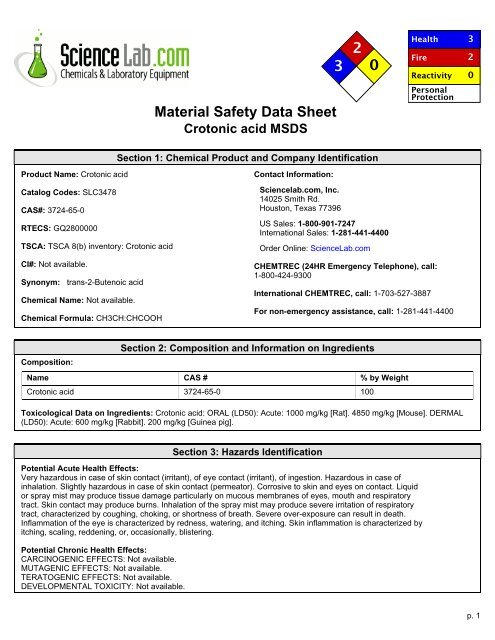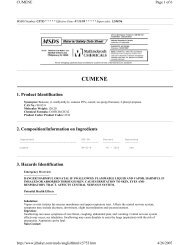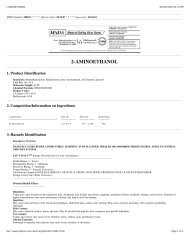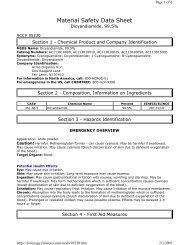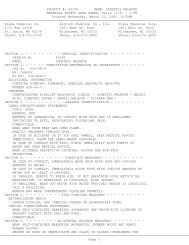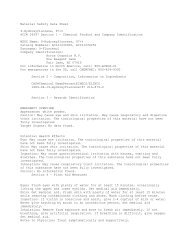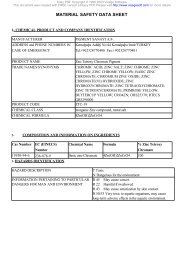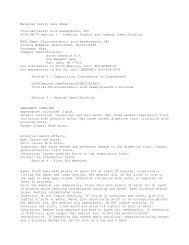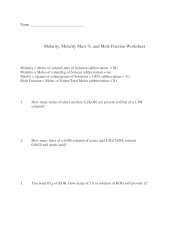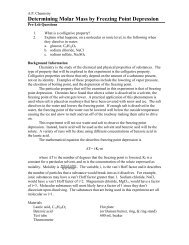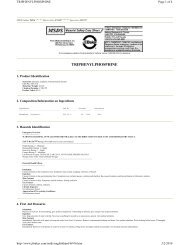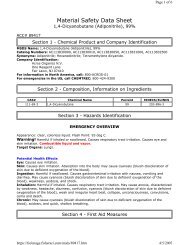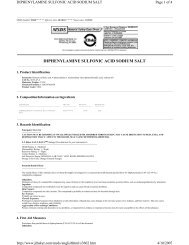MSDS PDF/C/Crotonic acid.pdf
MSDS PDF/C/Crotonic acid.pdf
MSDS PDF/C/Crotonic acid.pdf
Create successful ePaper yourself
Turn your PDF publications into a flip-book with our unique Google optimized e-Paper software.
Material Safety Data Sheet<strong>Crotonic</strong> <strong>acid</strong> <strong>MSDS</strong>Section 1: Chemical Product and Company IdentificationProduct Name: <strong>Crotonic</strong> <strong>acid</strong>Catalog Codes: SLC3478CAS#: 3724-65-0RTECS: GQ2800000TSCA: TSCA 8(b) inventory: <strong>Crotonic</strong> <strong>acid</strong>CI#: Not available.Synonym: trans-2-Butenoic <strong>acid</strong>Chemical Name: Not available.Chemical Formula: CH3CH:CHCOOHContact Information:Sciencelab.com, Inc.14025 Smith Rd.Houston, Texas 77396US Sales: 1-800-901-7247International Sales: 1-281-441-4400Order Online: ScienceLab.comCHEMTREC (24HR Emergency Telephone), call:1-800-424-9300International CHEMTREC, call: 1-703-527-3887For non-emergency assistance, call: 1-281-441-4400Composition:Section 2: Composition and Information on IngredientsName CAS # % by Weight<strong>Crotonic</strong> <strong>acid</strong> 3724-65-0 100Toxicological Data on Ingredients: <strong>Crotonic</strong> <strong>acid</strong>: ORAL (LD50): Acute: 1000 mg/kg [Rat]. 4850 mg/kg [Mouse]. DERMAL(LD50): Acute: 600 mg/kg [Rabbit]. 200 mg/kg [Guinea pig].Section 3: Hazards IdentificationPotential Acute Health Effects:Very hazardous in case of skin contact (irritant), of eye contact (irritant), of ingestion. Hazardous in case ofinhalation. Slightly hazardous in case of skin contact (permeator). Corrosive to skin and eyes on contact. Liquidor spray mist may produce tissue damage particularly on mucous membranes of eyes, mouth and respiratorytract. Skin contact may produce burns. Inhalation of the spray mist may produce severe irritation of respiratorytract, characterized by coughing, choking, or shortness of breath. Severe over-exposure can result in death.Inflammation of the eye is characterized by redness, watering, and itching. Skin inflammation is characterized byitching, scaling, reddening, or, occasionally, blistering.Potential Chronic Health Effects:CARCINOGENIC EFFECTS: Not available.MUTAGENIC EFFECTS: Not available.TERATOGENIC EFFECTS: Not available.DEVELOPMENTAL TOXICITY: Not available.p. 1
Repeated or prolonged contact with spray mist may produce chronic eye irritation and severe skin irritation.Repeated or prolonged exposure to spray mist may produce respiratory tract irritation leading to frequent attacksof bronchial infection. Repeated exposure to an highly toxic material may produce general deterioration of healthby an accumulation in one or many human organs.Section 4: First Aid MeasuresEye Contact: Check for and remove any contact lenses. Do not use an eye ointment. Seek medical attention.Skin Contact:If the chemical got onto the clothed portion of the body, remove the contaminated clothes as quickly as possible,protecting your own hands and body. Place the victim under a deluge shower. If the chemical got on the victim'sexposed skin, such as the hands : Gently and thoroughly wash the contaminated skin with running water andnon-abrasive soap. Be particularly careful to clean folds, crevices, creases and groin. If irritation persists, seekmedical attention. Wash contaminated clothing before reusing.Serious Skin Contact:Wash with a disinfectant soap and cover the contaminated skin with an anti-bacterial cream. Seek immediatemedical attention.Inhalation: Allow the victim to rest in a well ventilated area. Seek immediate medical attention.Serious Inhalation:Evacuate the victim to a safe area as soon as possible. Loosen tight clothing such as a collar, tie, belt orwaistband. If breathing is difficult, administer oxygen. If the victim is not breathing, perform mouth-to-mouthresuscitation. WARNING: It may be hazardous to the person providing aid to give mouth-to-mouth resuscitationwhen the inhaled material is toxic, infectious or corrosive. Seek immediate medical attention.Ingestion:Do not induce vomiting. Examine the lips and mouth to ascertain whether the tissues are damaged, a possibleindication that the toxic material was ingested; the absence of such signs, however, is not conclusive. Loosentight clothing such as a collar, tie, belt or waistband. If the victim is not breathing, perform mouth-to-mouthresuscitation. Seek immediate medical attention.Serious Ingestion: Not available.Flammability of the Product: Combustible.Auto-Ignition Temperature: Not available.Flash Points: CLOSED CUP: 88°C (190.4°F).Flammable Limits: Not available.Section 5: Fire and Explosion DataProducts of Combustion: These products are carbon oxides (CO, CO2).Fire Hazards in Presence of Various Substances: Not available.Explosion Hazards in Presence of Various Substances:Risks of explosion of the product in presence of mechanical impact: Not available.Risks of explosion of the product in presence of static discharge: Not available.Fire Fighting Media and Instructions:SMALL FIRE: Use DRY chemical powder.LARGE FIRE: Use water spray, fog or foam. Do not use water jet.Special Remarks on Fire Hazards: Not available.p. 2
Special Remarks on Explosion Hazards: Not available.Section 6: Accidental Release MeasuresSmall Spill: Absorb with an inert material and put the spilled material in an appropriate waste disposal.Large Spill:Combustible material. Corrosive liquid.Keep away from heat. Keep away from sources of ignition. Stop leak if without risk. Absorb with DRY earth,sand or other non-combustible material. Do not get water inside container. Do not touch spilled material. Usewater spray curtain to divert vapor drift. Prevent entry into sewers, basements or confined areas; dike if needed.Eliminate all ignition sources. Call for assistance on disposal.Section 7: Handling and StoragePrecautions:Keep locked up Keep container dry. Keep away from heat. Keep away from sources of ignition. Ground allequipment containing material. Do not ingest. Do not breathe gas/fumes/ vapour/spray. Never add water to thisproduct In case of insufficient ventilation, wear suitable respiratory equipment If ingested, seek medical adviceimmediately and show the container or the label. Avoid contact with skin and eyesStorage:Flammable materials should be stored in a separate safety storage cabinet or room. Keep away from heat. Keepaway from sources of ignition. Keep container tightly closed. Keep in a cool, well-ventilated place. Ground allequipment containing material. Keep container dry. Keep in a cool place.Section 8: Exposure Controls/Personal ProtectionEngineering Controls:Provide exhaust ventilation or other engineering controls to keep the airborne concentrations of vapors below theirrespective threshold limit value. Ensure that eyewash stations and safety showers are proximal to thework-station location.Personal Protection:Face shield. Full suit. Vapor respirator. Be sure to use an approved/certified respirator or equivalent. Gloves.Boots.Personal Protection in Case of a Large Spill:Splash goggles. Full suit. Vapor respirator. Boots. Gloves. A self contained breathing apparatus should beused to avoid inhalation of the product. Suggested protective clothing might not be sufficient; consult a specialistBEFORE handling this product.Exposure Limits: Not available.Section 9: Physical and Chemical PropertiesPhysical state and appearance: Liquid.Odor: Not available.Taste: Not available.Molecular Weight: 86.09 g/moleColor: Not available.pH (1% soln/water): Not available.p. 3
Boiling Point: 185°C (365°F)Melting Point: 71.6°C (160.9°F)Critical Temperature: Not available.Specific Gravity: 0.964 (Water = 1)Vapor Pressure: Not available.Vapor Density: Not available.Volatility: Not available.Odor Threshold: Not available.Water/Oil Dist. Coeff.: Not available.Ionicity (in Water): Not available.Dispersion Properties: Not available.Solubility: Not available.Section 10: Stability and Reactivity DataStability: The product is stable.Instability Temperature: Not available.Conditions of Instability: Not available.Incompatibility with various substances: Not available.Corrosivity: Non-corrosive in presence of glass.Special Remarks on Reactivity: Not available.Special Remarks on Corrosivity: Not available.Polymerization: No.Routes of Entry: Eye contact. Inhalation. Ingestion.Toxicity to Animals:Acute oral toxicity (LD50): 1000 mg/kg [Rat].Acute dermal toxicity (LD50): 200 mg/kg [Guinea pig].Chronic Effects on Humans: Not available.Other Toxic Effects on Humans:Very hazardous in case of skin contact (irritant), of ingestion.Hazardous in case of inhalation.Slightly hazardous in case of skin contact (permeator).Special Remarks on Toxicity to Animals: Not available.Section 11: Toxicological InformationSpecial Remarks on Chronic Effects on Humans: Not available.p. 4
Special Remarks on other Toxic Effects on Humans: Not available.Ecotoxicity: Not available.BOD5 and COD: Not available.Section 12: Ecological InformationProducts of Biodegradation:Possibly hazardous short term degradation products are not likely. However, long term degradation products mayarise.Toxicity of the Products of Biodegradation: The products of degradation are more toxic.Special Remarks on the Products of Biodegradation: Not available.Waste Disposal:Section 13: Disposal ConsiderationsSection 14: Transport InformationDOT Classification: CLASS 8: Corrosive liquid.Identification: : <strong>Crotonic</strong> Acid : UN2823 PG: IIISpecial Provisions for Transport: Not available.Federal and State Regulations:Pennsylvania RTK: <strong>Crotonic</strong> <strong>acid</strong>Florida: <strong>Crotonic</strong> <strong>acid</strong>Massachusetts RTK: <strong>Crotonic</strong> <strong>acid</strong>New Jersey: <strong>Crotonic</strong> <strong>acid</strong>TSCA 8(b) inventory: <strong>Crotonic</strong> <strong>acid</strong>Section 15: Other Regulatory InformationOther Regulations: OSHA: Hazardous by definition of Hazard Communication Standard (29 CFR 1910.1200).Other Classifications:WHMIS (Canada):CLASS B-3: Combustible liquid with a flash point between 37.8°C (100°F) and 93.3°C(200°F).CLASS D-1A: Material causing immediate and serious toxic effects (VERY TOXIC).CLASS E: Corrosive liquid.DSCL (EEC):R21/22- Harmful in contact with skinand if swallowed.R38- Irritating to skin.R41- Risk of serious damage to eyes.HMIS (U.S.A.):Health Hazard: 3p. 5
Fire Hazard: 2Reactivity: 0Personal Protection:National Fire Protection Association (U.S.A.):Health: 3Flammability: 2Reactivity: 0Specific hazard:Protective Equipment:Gloves.Full suit.Vapor respirator. Be sure to use anapproved/certified respirator orequivalent. Wear appropriate respiratorwhen ventilation is inadequate.Face shield.References: Not available.Other Special Considerations: Not available.Created: 10/09/2005 05:00 PMLast Updated: 10/09/2005 05:00 PMSection 16: Other InformationThe information above is believed to be accurate and represents the best information currently available to us. However, wemake no warranty of merchantability or any other warranty, express or implied, with respect to such information, and weassume no liability resulting from its use. Users should make their own investigations to determine the suitability of theinformation for their particular purposes. In no event shall ScienceLab.com be liable for any claims, losses, or damages of anythird party or for lost profits or any special, indirect, incidental, consequential or exemplary damages, howsoever arising, evenif ScienceLab.com has been advised of the possibility of such damages.p. 6


